Peak Pleasure in the Haut-Languedoc Mountains
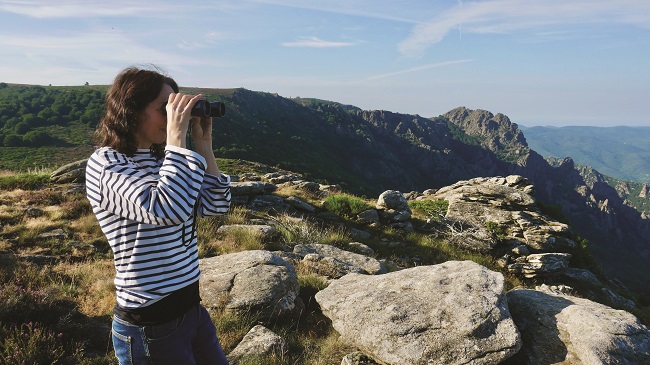
The Haut-Languedoc regional park is a wonderful playground for outdoor enthusiasts who will enjoy playing hide-and-seek with the local mouflons as well as hiking, cycling, canoeing and more!
We train our binoculars here, we train them there, but we cannot spot les mouflons anywhere. ‘What are mouflons?’ you ask. They’re wild mountain sheep that were introduced into the Haut-Languedoc Regional Nature Park from Corsica in 1956. But they’re somewhat skittish, so it’s best to look for them either early in the morning just after sunrise or in the evening when, once again, they have the wilds of the park virtually to themselves.
It’s a shame about the sheep, but the landscape more than compensates. It is early July and the earth, baked dry under the midi sun, is carpeted in glorious purple heather (bruyère) interwoven with dense patches of gorse that bloom golden yellow in the spring. It is also studded with outcrops of craggy, greyish-white gneiss, a type of rock speckled with quartz. Elsewhere, there are verdant pine and oak trees, and in the distance, jagged peaks stand sentinel over deep gorges.
Altogether, this makes the scenery strongly reminiscent of the Lake District or the Scottish Highlands. But, as well as boasting plenty of sunshine across the year and its own special character, the Parc Naturel Régional du Haut-Languedoc offers a richly biodiverse and unspoilt environment that attracts nature lovers from far and wide, even if it remains relatively undiscovered. Created in 1973, it covers an area of more than 300,000 hectares, lying at the southern end of the Massif Central and spanning the Hérault and Tarn départements in roughly equal measure. Its many attractions include the Cathar village of Minerve to the south, and the gigantic, gravity-defying rocks of Sidobre to the northwest.
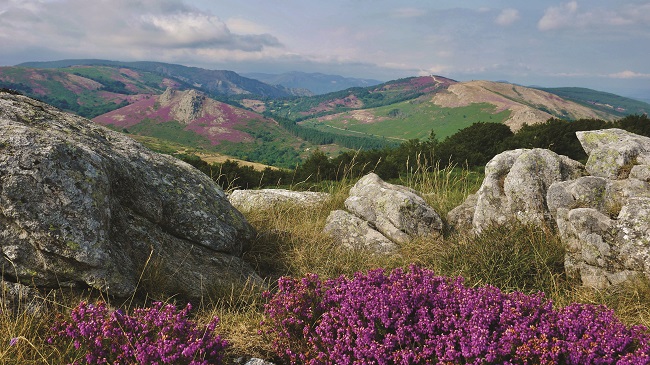
The picturesque plateau du Caroux © Stephen Turnbull
But arguably the most picturesque part, and certainly the most spectacular, lies at its heart in Hérault. This is dominated by the mighty Caroux-Éspinouse massif, where the mouflons roam, and the River Orb, from which the Vallée de l’Orb takes its name. The river winds its way along the valley from east to west, then courses southwards via the historic city of Béziers, before reaching the Mediterranean. Later, accompanied by Jean-Christophe Mahieu from the local tourist office, we are treated to a fascinating talk on the sheep by our guide, Olivier Lefebvre.
Fetching out some large, spiral-shaped horns from his satchel, he tells us these belonged to adult males and explains that their prominent ridges indicate years of growth, similar to tree rings. He then points out that males become increasingly solitary as they age, although, like the females, they are quite gregarious and inquisitive in their youth. Our mouflon ‘hunt’ over (actual hunting of the animals is strictly regulated), we trundle back to the hamlet of Douch from where we’d set out. With its typically rustic stone buildings, which include a communal bread oven and several gîtes, Douch serves as an outdoor activity hub, particularly for hikers drawn to the many wonderful walks in the area.

A mouflon © shutterstock
The most popular of these, the Randonnée du Sommet du Caroux, takes in the Table d’Orientation, a superb belvedere offering marvellous views of the Orb and Jaur valleys below and the Mediterranean and Pyrenees beyond. Arriving in Douch, we finally clap eyes on a mouflon, and a magnificent male one at that – sadly, it is in the form of a statue erected in 2019. However, this celebrates the success of the park in enabling the species to thrive (its population of around 2,000 is now the largest in France) and in turning it into an instantly recognisable emblem.
Afterwards, we take a short drive up the valley to explore the Gorges d’Héric. Carved deep into the mountainous rock of Caroux by the elements, and protected as a natural site since 1993, this is a truly breathtaking beauty spot, with a cascading stream that feeds a chain of waterfalls and emerald pools. The further you go up the gorge along the wide and gently climbing path, which doubles as a nature trail, the more chance you have of finding a secluded spot to enjoy a refreshing paddle or dip and a well-earned picnic. Not surprisingly, the site is also popular with hikers who venture to the hamlet of Héric, about 5km upstream, and beyond, as well as climbers and other outdoor activity enthusiasts. However, it’s the kind of place that anyone of any age can enjoy, although it’s better to come off-season when it’s much quieter.
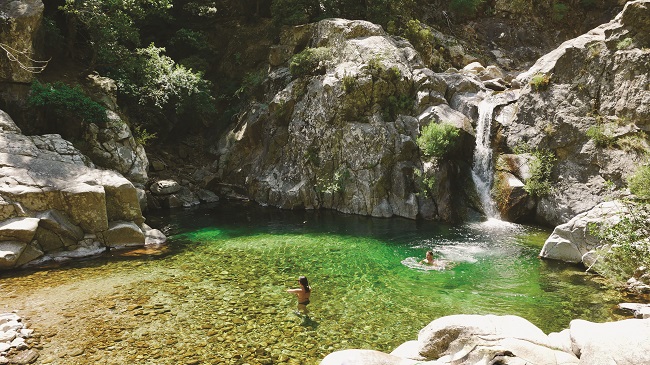
One of the ’emeral pools’ at the gorgeous Gorges d’Héric © Stephen Turnbull
Beautiful villages
To finish off our fun-packed day as far as the activities go, we take an e-bike ride from the pretty village of Mons-la-Trivalle at the foot of Caroux, down the Passa Païs. Formerly a railway line, this is part of the Voie Verte (Green Way) national network and stretches almost 80km from Bédarieux in the east to Mazamet in the west. As well as more marvellous views of the valley and mountains, it offers plenty of cooling shade from tunnels and overhanging trees, and unlike the terrain in general, is mostly flat. This makes it perfect for walking and horse riding too.
In the evening, we stroll through the picture-perfect Plus Beau Village of Olargues and take our table at the appropriately named Fleurs d’Olargues. The gastronomic food and excellent service are second to none, and if there is a more romantic setting for a restaurant anywhere in the south of France, I have yet to see it.
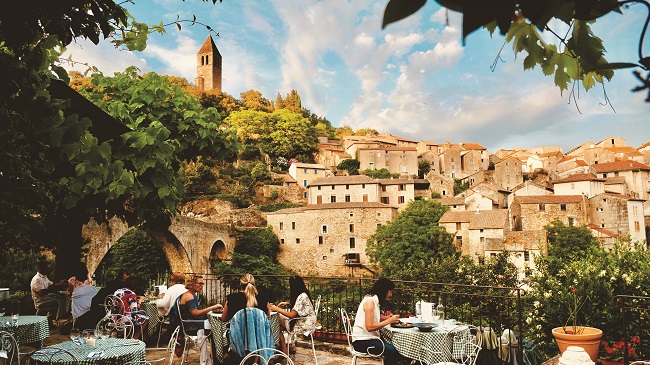
The wonderfully romantic Fleurs d’Olargues restaurant © Stephen Turnbull
The following morning we take a 20-minute drive to Roquebrun at the southern edge of the park. Known locally as ‘Le Petit Nice’ (because its position looking down on the River Orb is reminiscent of the views from the corniche on the Mediterranean coast), this is another gem of a village, with its Mediterranean gardens full of exotic plants.
But its main attraction is the canoeing, provided by Canoë Roquebrun. The company offers a variety of trips (some lasting two to three days) to suit all ages and abilities. And as we soon discover, there is plentiful wonderful wildlife as well as white water thrills to enjoy on the river. But best of all is the glorious scenery and the long stretches of water where it is so peaceful the sound of your oar dipping in the water is all you can hear.
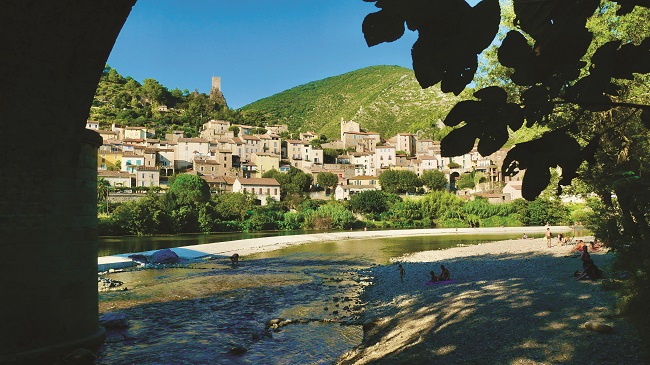
Roquebrun and its beautiful ‘beach’ © Stephen Turnbull
Later, we conclude our trip to Haut-Languedoc with a visit to the Domaine du Vieux Chai, a vineyard back up the valley in the charming hamlet of Ceps which we passed earlier in the canoe. The domaine is run by two sisters, Sophie and Florence Jean-Laguna, the latest generation of a long-standing family business. Their wines are labelled as ‘haute valeur environnementale’, which means technically they are not organic, but they are produced under the acclaimed Saint-Chinian AOC and, judging from our tasting, reflect the richness of its terroir. So the secret is out. The mountainous heart of the Haut-Languedoc Regional Nature Park may not be widely known, but it holds a natural paradise with a host of attractions.
No wonder so many keep coming back.
From France Today magazine
Share to: Facebook Twitter LinkedIn Email
More in Haut-Languedoc, Massif Central, mountains, natural regional park, outdoor activities in France, wildlife
Leave a reply
Your email address will not be published. Required fields are marked *



